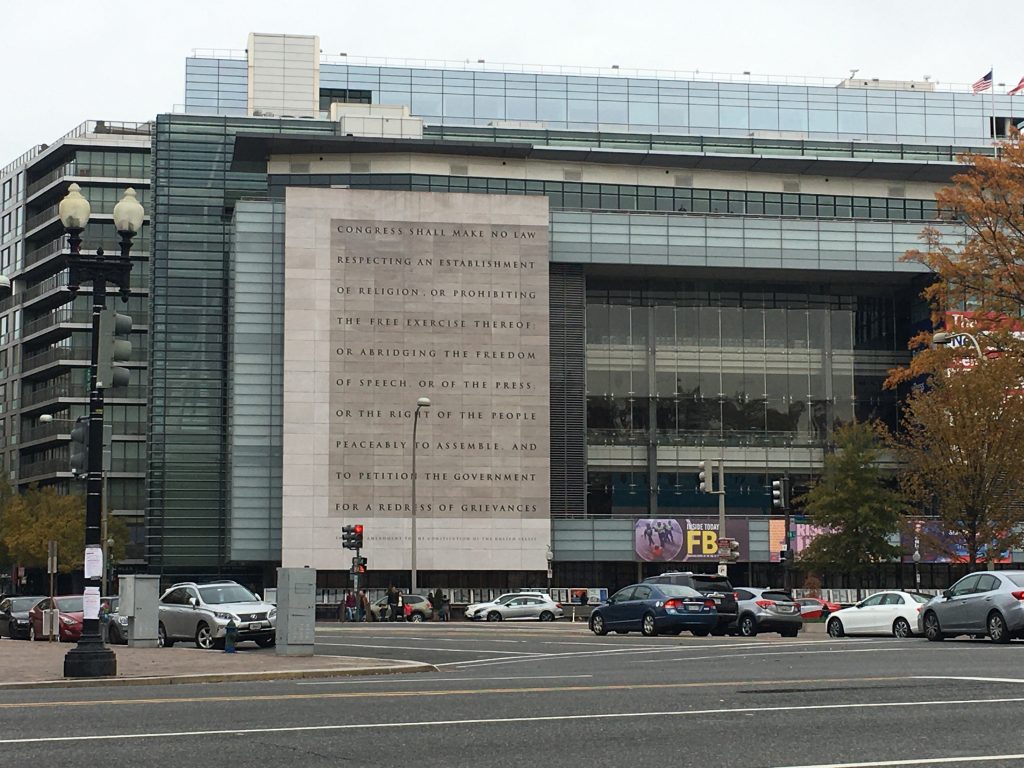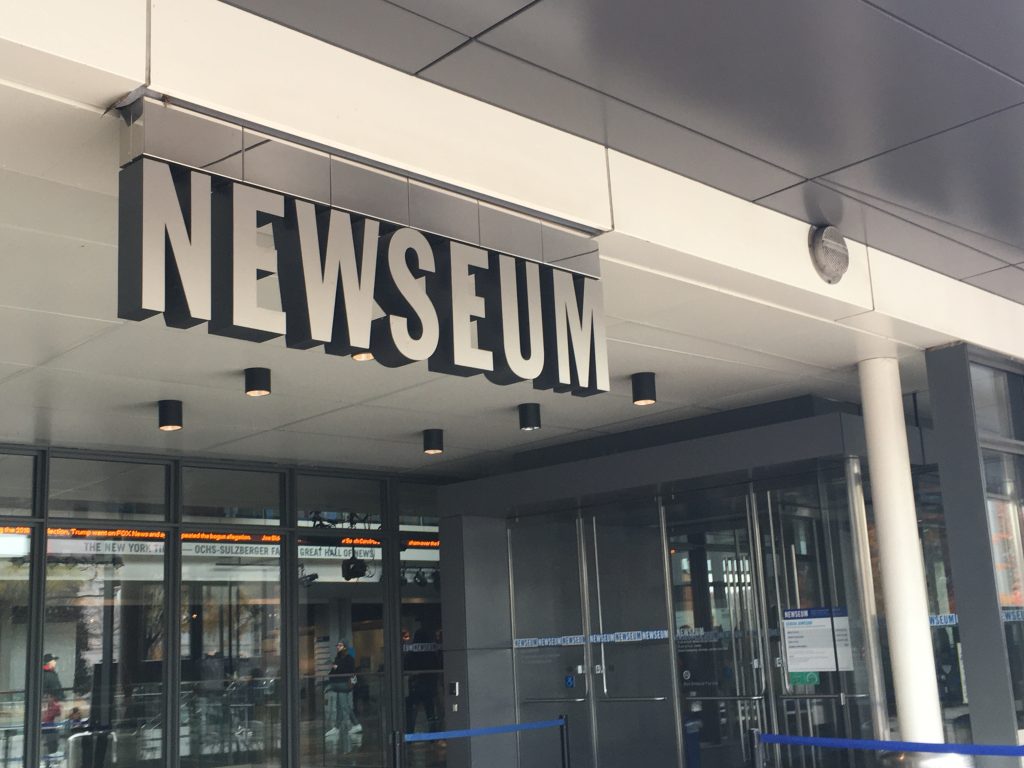Approaching the Newseum from afar is like walking toward a temple. A stone tablet inscribed with the First Amendment looms several stories tall above onlookers, granting hope and security to those who visit. Situated only a short walk from the Capitol Building, the facility holds records of a long and storied history of journalism, where icons are frozen in time and the echoes of past generations are preserved through treasured pamphlets of ink and paper. The Newseum illuminates the past and honors those who reported on it, and yet—come Dec. 31—will close its doors for the final time.
After struggling financially for a number of years, the Newseum announced on Jan. 25 that it would sell its building to Johns Hopkins University for use in housing D.C.-based graduate programs. Johns Hopkins will buy the property, a glassy seven-level building on Pennsylvania Avenue, for $372.5 million. Upon closing, the museum’s collection of artifacts and displays will go into storage in an out-of-District support center for use in public events and educational opportunities.
The Newseum opened in its current location in 2008 after moving across the Potomac from Arlington, Virginia, and was primarily funded by the Freedom Forum, a nonpartisan educational foundation. The closing, a product of unsustainable operating costs, reflects wider uncertainties about the financial sustainability of journalism organizations across the country.
In a city where free-to-enter public attractions are abundant, the Newseum charges nearly $25 per ticket—one of the highest museum admission fees in the District. Coupled with a 10 percent staff reduction in January 2017, this meant the threat of closure loomed over the organization for months before the official announcement.
Sonya Gavankar, director of public relations for the Newseum, elaborated on what the closing means for the future of Freedom Forum’s educational mission. “What we do really well is education in a very non-partisan way, and that will continue on with our education programs and convening of high level conversations,” Gavankar said.
The financial difficulties behind the closure date back to the recession in 2008. Since then, the museum has lost between $2.5 million and $8 million annually. Just in 2017, the most recent year for which records are available, the organization lost almost $5 million. Despite these losses, executives at the non-profit museum still received large salaries—including former president and CEO Jeffrey Herbst, whose salary totaled $721,108 in 2017. Herbst resigned in August of that year amid a financial review by the museum’s board.
Herbst was not alone, as the Newseum has seen dramatic turnover in executive positions in recent years. Gary Officer, former senior vice president and chief development officer, also resigned in 2017 after only a year in the position to take a new position as president and CEO of Senior Service America. Former Chief Operating Officer Scott Williams, who served as Newseum president beginning in March 2018, left late that August after only a six-month tenure.
Tara Ravishankar (COL ’22), who works at the Newseum as a tour guide, is a native of the D.C. area and described how the museum impacted her growing up. “The Newseum has been such an important part of me becoming an adult, I think. It made me understand that the world isn’t as bright and shiny as I once thought it was.”
Through its years of operation, the Newseum has hosted a variety of different exhibits, all of which presented the broader field of journalism from an unconventional angle. These displays cover many different mediums, including broadcast journalism, photography, and classic pen-and-paper reporting. This, in conjunction with the wide range of reporting beats showcased—music, celebrity, civil rights, war, immigration—indicates just how central the contributions of journalists remain in American life.
Each artifact stored within the Newseum’s walls occupies a unique spot within the wider story of journalism. Some of the museum’s most recent additions include the notebook of Washington Post reporter David Fahrenthold, who received the 2017 Pulitzer Prize for his investigations into the exaggerated philanthropy of then-presidential candidate Donald Trump, as well as the broken glasses of Ben Jacobs, a Guardian reporter who was assaulted by Rep. Greg Gianforte (R-MT) in May 2017.
These recent additions join an already impressive collection: an 1829 copy of the first Native American newspaper, the Cherokee Phoenix; protest signs from the 2014 unrest in Ferguson, Missouri; the press passes of Jorge Ramos, K.W. Lee, and other leading journalists from diverse backgrounds. Held in showcases such as the Bloomberg Internet, TV, and Radio Gallery and the News Corporation News History Gallery, the Newseum’s collection is comprehensive.
Upon closing, the collection will be cleared out and the building will undergo renovations. This construction, scheduled to begin in autumn of next year, will take approximately two and a half years to complete. Mitch Bonanno, chief real estate officer for Johns Hopkins, wrote in an email to the Voice that the facility is a “unique, purpose-built property that will require significant renovations and governmental reviews for conversion to academic use.”

Photo by John Woolley The Newseum from a distance.Photo by John Woolley
Within the newly renovated space, Johns Hopkins would consolidate its existing D.C. graduate programs, currently spread across the District, into a single location. These programs include a number of divisions within the university, such as the Paul H. Nitze School of Advanced International Studies, Krieger School of Arts and Sciences, the Carey Business School, and the School of Nursing.
In an announcement letter from his office, Johns Hopkins University President Ronald Daniels voiced his excitement for the move. “The renovated building will provide opportunities for every academic division of the university to pursue research and educational activities in Washington—complementing and drawing on those conducted on our flagship Baltimore campuses and deepening our connections to debates over national and global policy,” he wrote. In order to pay for the facility, Daniels cited funds from selling the university’s existing D.C. properties, as well as general university funds and philanthropic contributions.
On a larger scale, Daniels described the move as a way for Johns Hopkins to integrate itself into the wider D.C. community. “Our commitment to contributing our ideas and expertise to these debates lies at the core of what it means to be a vital and relevant university,” he wrote.
For consumers, the biggest change coming with the Newseum’s closure will be the potentially permanent dismantling of the facility’s many exhibitions. The Newseum’s current (and final) line-up includes a number of stand-outs.
“Seriously Funny,” located on the second floor, is a history of Jon Stewart’s The Daily Show, and how his style went on to inspire a number of current political comedy shows. Just a few levels above lies “Rise Up,” a display showcasing the history of the LGBTQ+ rights movement in the United States following the 1969 Stonewall riots. These exhibits, among others, showcase the diversity present in the facilities’ collection.
Ravishankar highlighted the Journalists Memorial, located on the third floor. Rising two stories above visitors, the glass monument’s surface bears the names of journalists who have been killed while reporting. “It is because of the names on this wall that massively important stories are told,” she said. “We need to keep protecting these people who tell us these stories, because they are what protect our humanity.”
The Newseum’s 9/11 Gallery is uniquely striking. Located on the fourth floor of the museum, it houses a massive fragment recovered from the World Trade Center site. Towering behind the monument is a wall covered top-to-bottom with newspaper front pages from the day after the attack. Publications from across the world are on display, mounted in rows one after another, memorializing the ways different communities reacted to the attacks in the moment. The headlines vary—some predict war, some focus on the destruction, others on the loss of life—yet all are unified in a strange, melancholic solidarity.
Perhaps the most iconic of the Newseum’s exhibits, however, is the Pulitzer Prize Photography Gallery. This collection, situated right by the building’s entrance, showcases a collection of stunning photos dating back to the award’s creation in 1942. Inside the gallery are over a thousand images, digital and physical, making it the most comprehensive gallery of Pulitzer Prize-winning photographs in the world. Here, the memories captured range from historic success to unthinkable tragedy.
“The Pulitzer photos were unbelievable. Just heart wrenching to see those moments captured,” said Glenn Krake, an Oregon journalism teacher who brought his students to see the museum a month before the scheduled closure. “The stories that don’t often get told, the photographers that put us where nobody else is able to see, and shine light on that—that’s powerful.”

Photo by John Woolley The Newseum’s entrance.Photo by John Woolley
Ravishankar echoed this sentiment. “Free press is so necessary because it allows us to humanize the conflicts that are occurring to people who don’t look like us, and it allows us to stay informed so that we don’t get complacent,” she said. “It’s so easy to write off violations of human rights in our hearts if we aren’t forced to care about them. Journalism takes away that ignorance.”
After the Newseum’s closing, some of these displays will still be circulated for educational programs, loans, and public events. Currently, the Newseum operates a pop-up exhibit in both Dulles and Reagan Airports marking the 30th anniversary of the fall of the Berlin Wall. This showcase will continue operation until February 2020 and will be followed by a new exhibit on women’s suffrage to coincide with the 100th anniversary of the 19th Amendment’s ratification.
Once the building is closed to visitors, removal of the exhibits is projected to take at least six months. While Newseum leadership has not announced any concrete plans to reopen, it has expressed interest in finding a new location once the sale is complete.
Krake spoke about how the Newseum’s closure reflected a wider uncertainty about journalism today. “It’s heartbreaking. We talk about the U.S. being a place of free speech, yet we’re not free of the bondage of capitalism—which I kind of say that in jest—but we kind of are slaves to the economy if we don’t have a way to make it pay for itself,” Krake said. “It’s sad. I don’t know what the answer is.”
Journalistic organizations around the country face comparable economic hardship. According to a 2018 research study by the University of North Carolina at Chapel Hill (UNC), nearly 20 percent of local newspapers have shut down since 2004.
Doyle McManus, director of the Journalism Department at Georgetown, lamented this changing landscape and placed emphasis on the importance of these local outlets. “The closing of the Newseum is a loss to the public—but not nearly as great a loss as the shrinkage and death of hundreds of local newspapers, which has deprived many Americans of essential information about the governments they pay for,” he said.
Rural newspapers are especially at risk of closure, creating “news deserts” where democratic accountability through the press is stunted. Nearly half of all counties in the United States have only a single publication, and almost 200 counties have no local newspaper whatsoever. Moreover, UNC found that this trend appears to be accelerating. Total weekday circulation, including weekly and daily papers, has declined by 49 million copies in the past 15 years—20 million of which was in the last four years alone.
This is not the only sign of the times—the number of journalists employed by newspapers has been cut in half since 2004 and the ownership of those papers has consolidated rapidly due to financial strain and shifting business models. Just 10 companies own nearly half of all daily papers in the United States, and fewer than one-third of U.S. weekly papers remain locally owned. In spite of this, Krake remains hopeful.
In particular, Krake focused on the role that future journalists, and students at large, have in supporting and maintaining the profession. “I think there’s hope that this next generation can sense truth,” he said. “It’s so important to be the voice for people who don’t have a voice. It’s important to shine a spotlight on injustice, and to bring truth, and to do it with credibility, to do it with honesty, to do it courageously. Our society depends on it.”





